Multibrand For WHMCS
About Multibrand For WHMCS
| Multibrand For WHMCS will allow you to manage multiple brands on multiple websites while using just one WHMCS license.
The module will allow you to easily personalize each brand by adjusting its client area template, logo, language and many other elements. |
- Addon Features:
| ✔ User-Friendly Management Of Multiple Brands |
| ✔ Easy Modification Of Existing Brands |
| ✔ Assign Ticket Departments To Brands |
| ✔ Assign Ticket Piping Email Addresses To Brands |
| ✔ Configure Payment Gateways For Each Brand |
| ✔ Configure Email Templates For Each Brand |
| ✔ Configure SMTP Mailboxes For Each Brand |
| ✔ Set Up Pricing Of Products, Addons, Domains And Bundles For Each Brand |
| ✔ Define Promotions For Each Brand |
| ✔ Display And Migrate Clients Between Brands |
| ✔ Display And Manage Relations Of Services, Invoices, Tickets, Knowledgebase, Downloads And Announcements |
| ✔ Toggle Invoice Branding |
| ✔ Toggle Brand Status |
| ✔ Toggle Auto Client Assignment |
| ✔ Toggle Pricing Branding |
| ✔ Toggle SMTP Settings Branding |
| ✔ View Monthly And Total Sale Amount Per Brand |
| ✔ View Dynamic Statistics On Each Brand |
| ✔ View Logs |
- Admin Area Features:
| ✔ Order Branded Products |
| ✔ Create Branded Clients |
| ✔ Create Branded Invoices |
| ✔ Create Branded Quotes |
| ✔ Create Branded Tickets |
| ✔ Create Branded Announcements |
| ✔ Add Branded Knowledgebase Articles |
| ✔ Add Branded Downloads |
| ✔ Send Branded Email Message To Single Or Multiple Clients |
| ✔ Display Brand Labels On The Lists Of Clients, Invoices, Orders, Tickets, Knowledgebase Articles, Announcements And Downloads |
| ✔ Invoice Selected Items On Client Summary |
| ✔ Log In As Client To Chosen Brand |
- Client Area Features:
| ✔ Display Client Area Template And Default Language Depending On Brand |
| ✔ Access Services, Invoices, Downloads, Ticket Departments And Payment Gateways Assigned To Brand |
| ✔ View Knowledgebase Articles And Announcements Assigned To Brand |
| ✔ Receive Branded Emails And Invoices |
| ✔ Assign Clients Automatically Upon Registration To Brand |
| ✔ Toggle Auto Assignment Of Clients When Logging In To Different Brand |
- Brand Configuration:
| ✔ Set Up Brand Name |
| ✔ Brand Company Name |
| ✔ Brand Domain Address |
| ✔ Brand Logo |
| ✔ Brand Default Language |
| ✔ Brand Template |
| ✔ Brand Order Template |
| ✔ Brand Address |
| ✔ Brand Signature |
| ✔ Brand Email Address |
| ✔ Brand Ticket Departments |
| ✔ Brand Graph Color |
| ✔ Brand Terms Of Service URL |
| ✔ Brand Invoice Sequential Number, Format And Pay To Text |
| ✔ Toggle Proforma Invoicing |
| ✔ Set Up Branded Or Normal Payment Gateways |
| ✔ Brand Email CSS Styling And Content |
| ✔ Brand Email Templates In Various Languages |
| ✔ Brand Affiliate URLs |
- Branded Payment Gateways:
| ✔ 2Checkout |
| ✔ Authorize.Net |
| ✔ Checkout.com |
| ✔ Payflow Pro |
| ✔ PayPal REST |
| ✔ Stripe |
| ✔ WePay |
- General Info:
| ✔ Multi-Language Support |
| ✔ Supports PHP 5.6 Up To PHP 7 |
| ✔ Supports WHMCS Template Six |
| ✔ Supports WHMCS V7 |
Installation
| This tutorial will show you how to successfully install and configure Multibrand For WHMCS. We will guide you step by step through the whole installation and configuration process. |
Installation
| 1. Log in to our client area and download the module. |
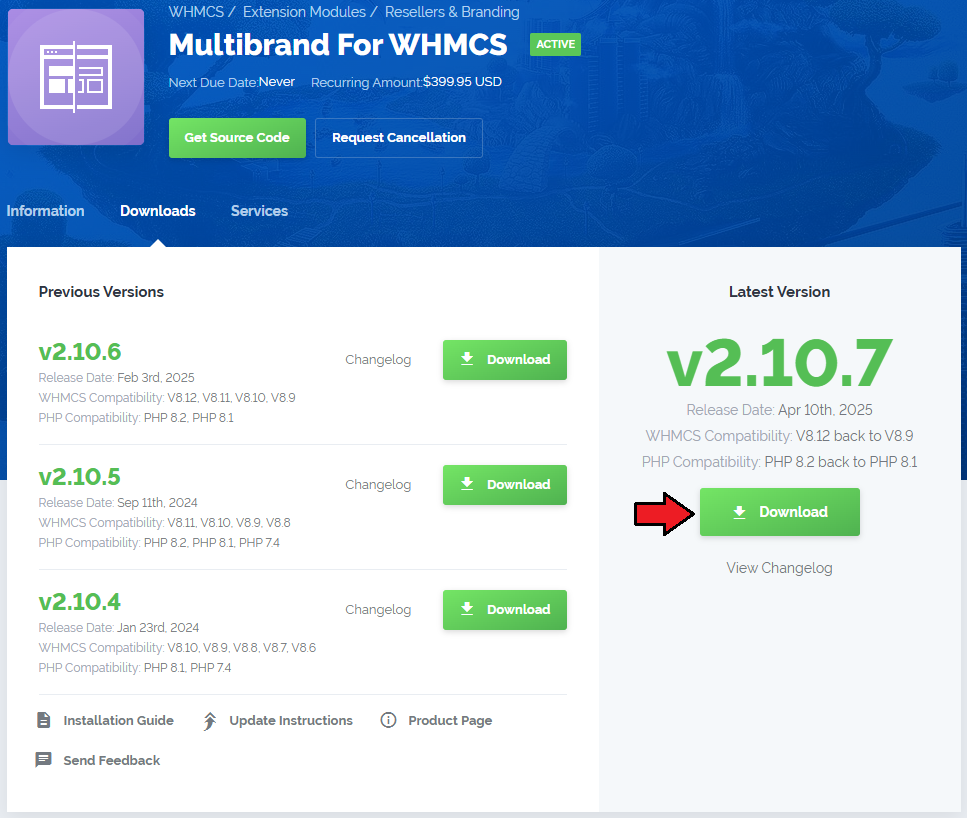
|
| 2. In the downloaded file you will find two packages that support different PHP versions. As presented on the screen below, the first one is dedicated to PHP 5.6 up to PHP 7.0, while the second one is aimed at PHP 7.1 up to PHP 7.2. It does not apply to open source versions. Note: You can check the current PHP version in your WHMCS. To do so, proceed to 'Utilities' › 'System' › 'PHP Info'. |

|
| 3. Extract the downloaded file and choose the one with the right PHP version. Upload and extract the PHP file into the main WHMCS directory. The content of PHP version files should look like this. |

|
| 4. When you install Multibrand For WHMCS for the first time, you have to rename 'license_RENAME.php' file. The file is located in 'modules/addons/MultibrandFunctionality/license_RENAME.php'. Rename it from 'license_RENAME.php' to 'license.php'. |
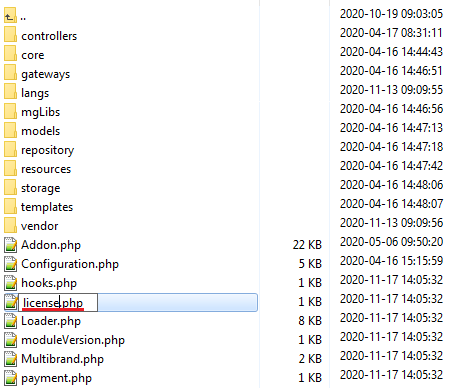
|
| 5. In order to configure your license key, you have to edit the previously renamed 'license.php' file. Enter your license key between quotation marks as presented on the following screen. You can find your license key in our client area → 'My Products'. |

|
Activating Addon Module
| 6. Now, you have to activate the module in your WHMCS system. Log in to your WHMCS admin area. Go to 'Setup' → 'Addon Modules'. Afterward, find 'Multibrand' and press the 'Activate' button. |
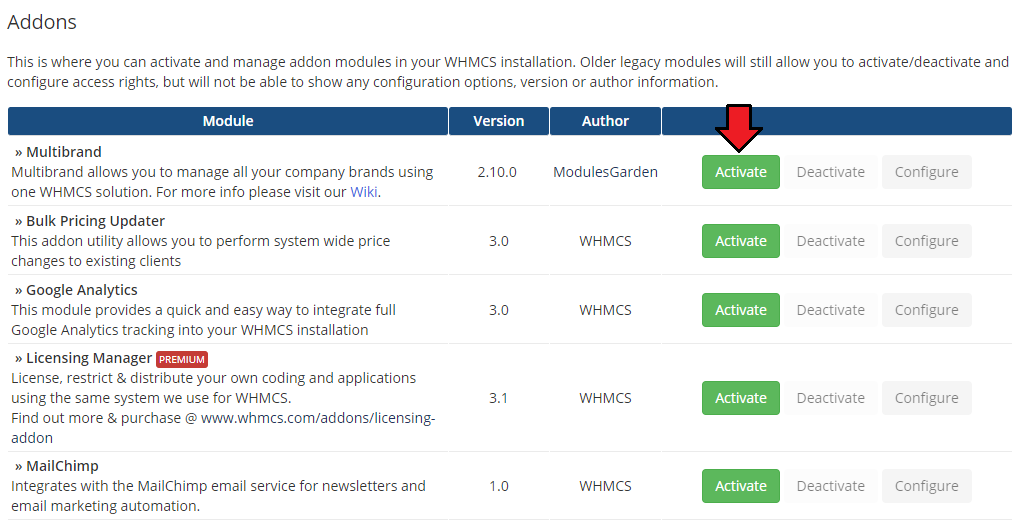
|
| 7. In the next step, you need to enable the hooks and grant access to this module. To do so, click on the 'Configure' button, go to the 'Access Control' area and check the required group of administrators. Press 'Save Changes'. |
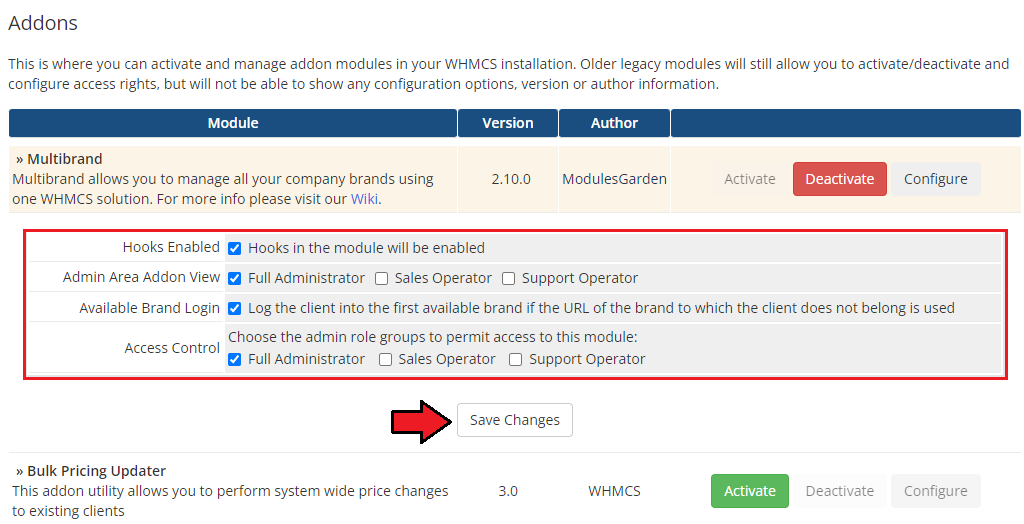
|
Additional Settings
| 8. Now, set up the 'storage' folder with its subfolders as recursively writable. This folder is available at 'your_whmcs/modules/addons/Multibrand/' . |
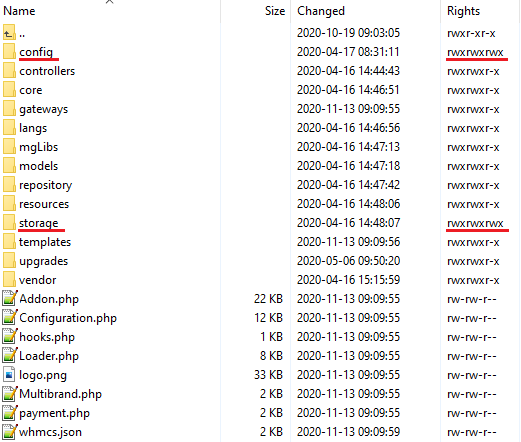
|
| 9. You will also need to set up 'gateways' and 'callback' folders as writable. The 'gateways' folder is located in 'your_whmcs/modules/' and the 'callback' folder in 'your_whmcs/modules/gateways' (do NOT mistake the folders with those located in the Multibrand addon) |
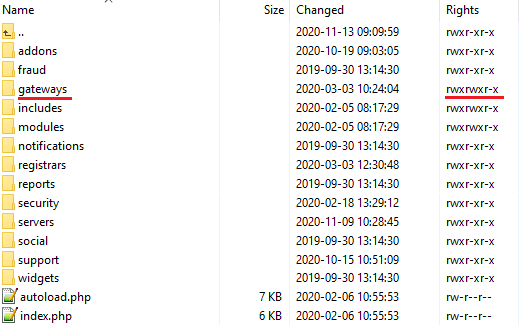
|
| 10. The next step is replacing the 'invoicepdf.tpl' file with 'invoicepdf_rename.tpl' for each of the templates used. The 'invoicepdf_rename.tpl' file is located in the 'your_whmcs/templates/six/' folder. |
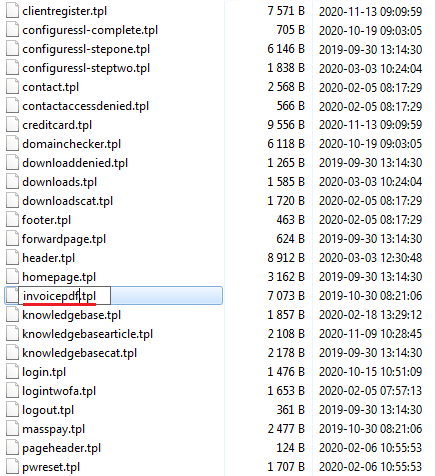
|
Integration Code
| 10. You can now access your Multibrand For WHMCS module. Simply go to 'Addons' → 'Multibrand'. But, before you can start using the module, you still need to set up the 'Integration Code'. It is required for the correct logo branding and it should be done for all brand templates that you want to use. |
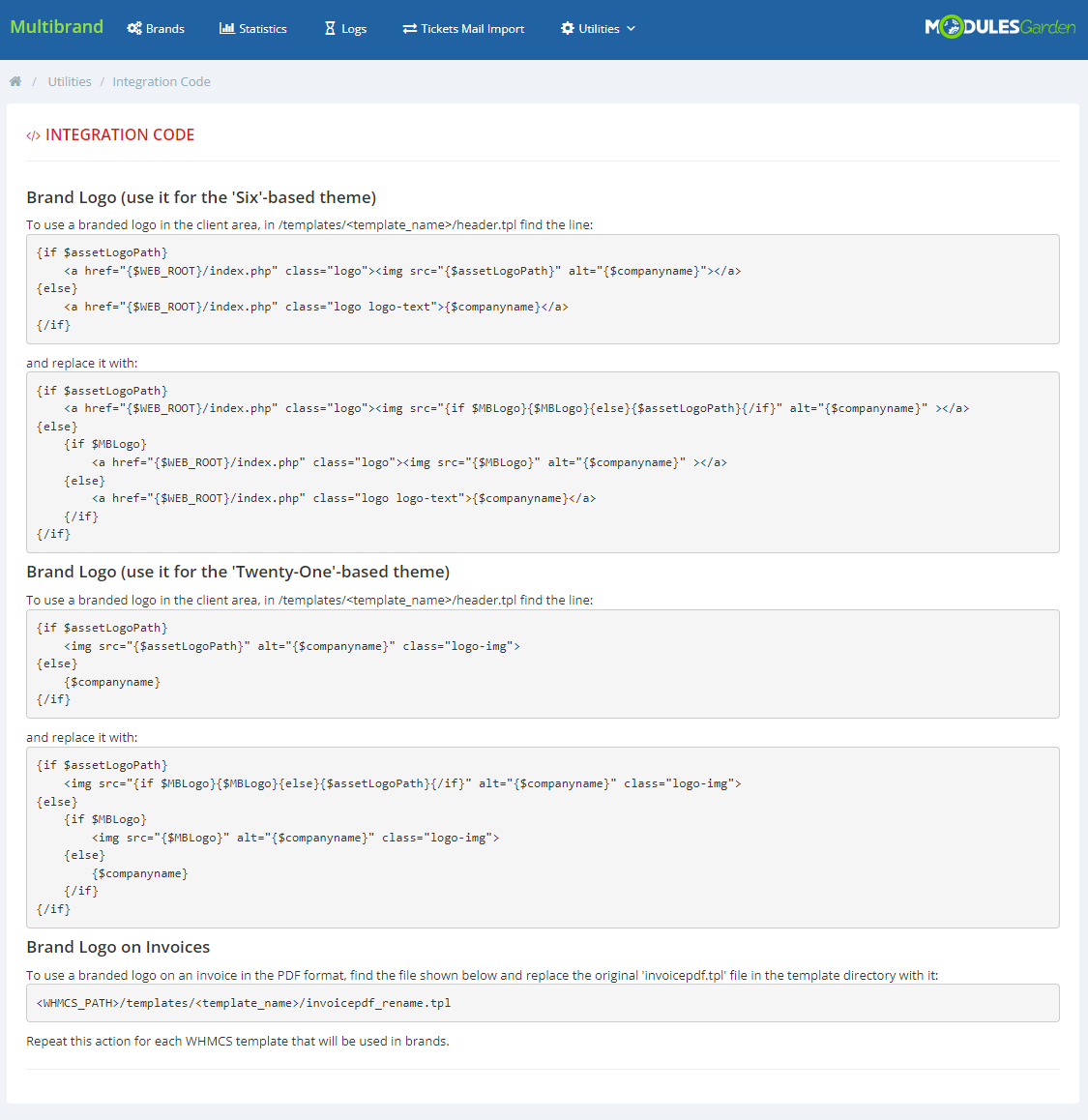
|
| 11. And that is all, you have completed the installation of the module. |
Configuration and Management
| In this section we will show you how to properly set up and use Multibrand For WHMCS. |
Brands
| In the 'Brands' tab you can create and manage your brands using a single instance of WHMCS platform. Note: If you have not used any of previous Multibrand versions before, after the module's activation, the first brand will be created automatically by default based on the main settings of your WHMCS. |
New Brand
| Let us start by creating a new brand. For that purpose, go to the 'Brands' tab and press 'Add a new brand' |
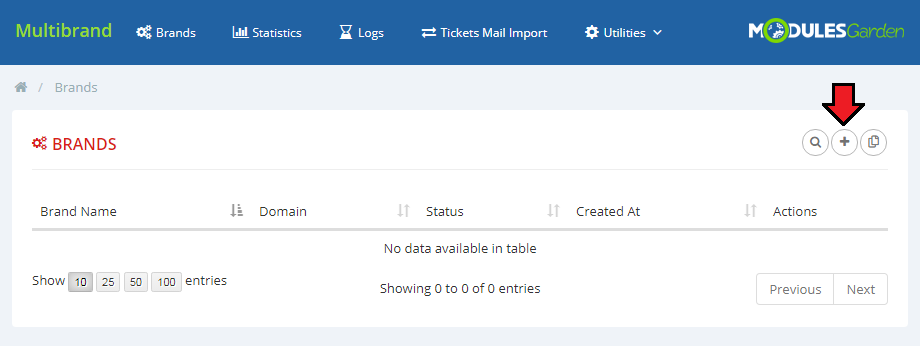
|
| Fill out the brands's 'Name' and 'Domain' with desired values and press the 'Save' button. |
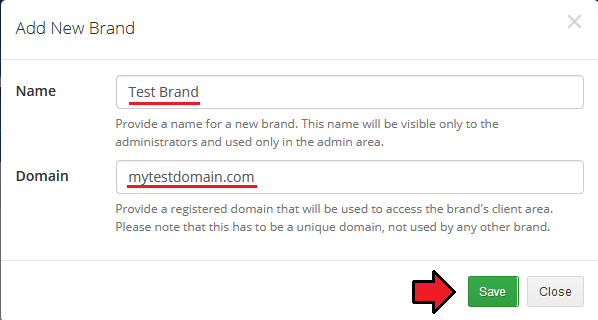
|
| Your first brand is ready. Next, click the 'Edit' ' |
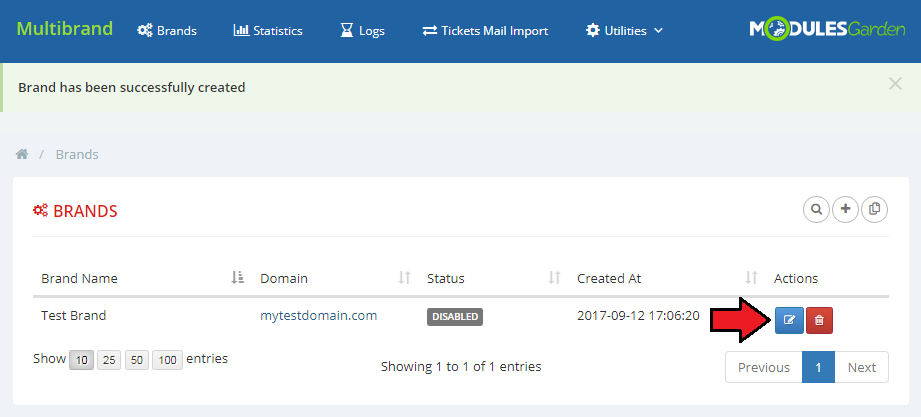
|
| You will be moved to the brand configuration area, where you can manage your brand's information and settings. |
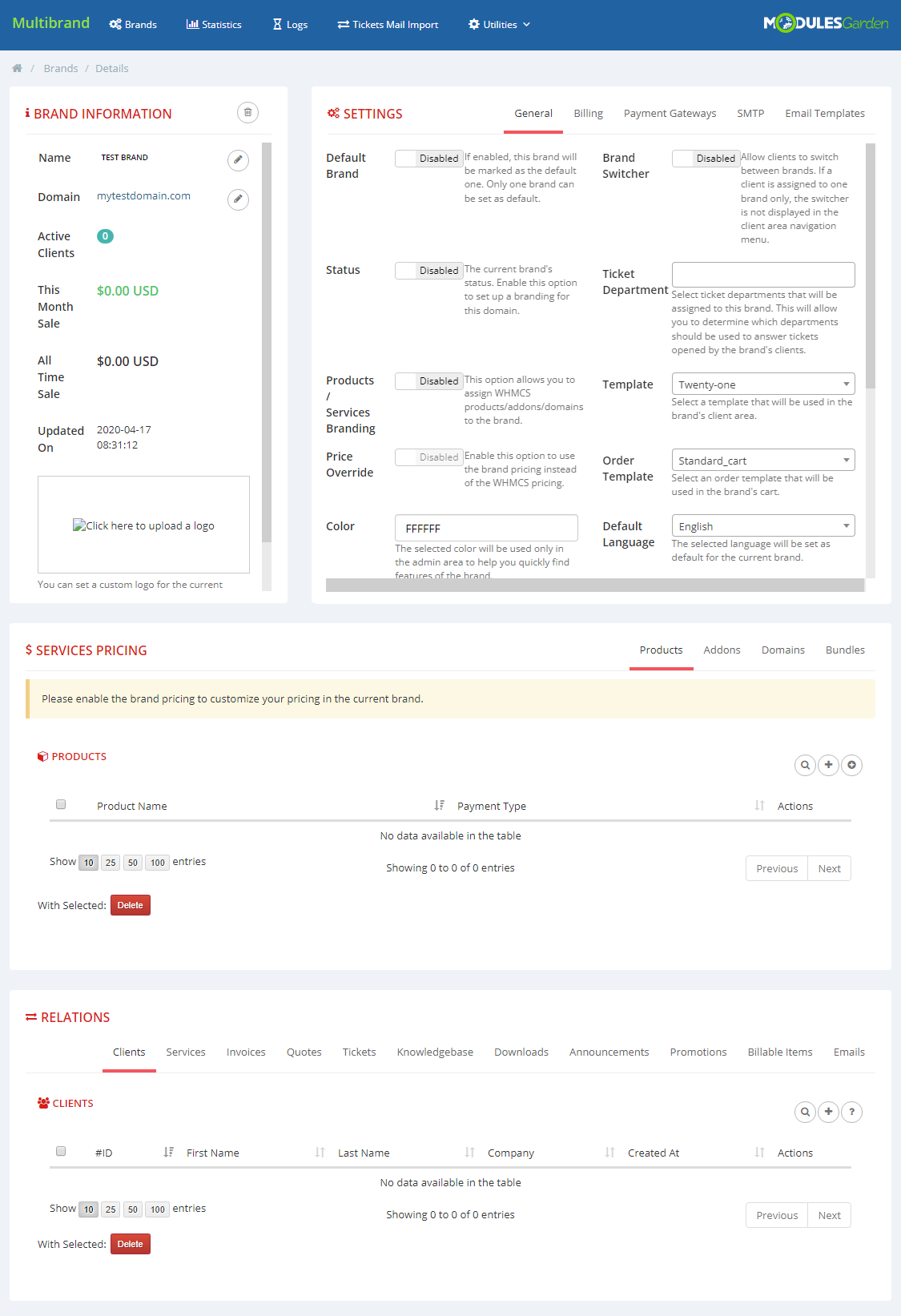
|
|
Note: Once the configuration of your brand is complete, you will need to set up a CNAME DNS record before the brand is published (status - enabled). |
Brand Information
| In the 'Brand Information' window, you can edit the brand name, domain name and custom logo. In addition, you can see the current month's revenue, total sales and the last update. |
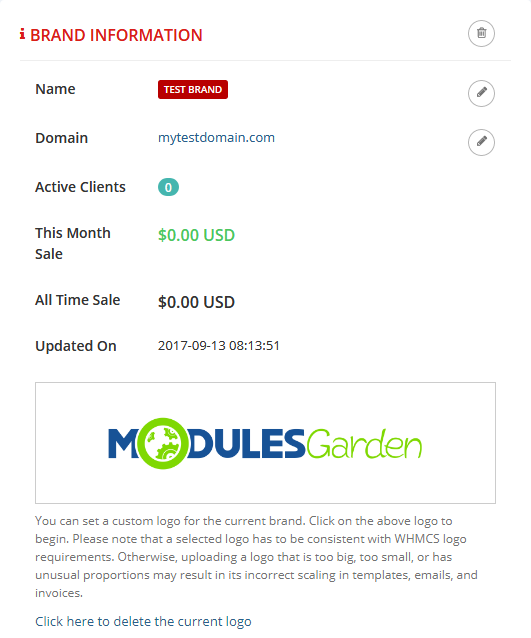
|
Settings
| In this window you will be able to configure the most important settings of your brand, including billing, payment gateways, SMTP and email templates configuration. |
General
| In the general settings you will configure the main options of a brand. First, fill out the brand's 'Email Address', 'Company Name' and 'TOS URL' . Next, choose the brand's 'Color', 'Ticket Departments' , 'Default Language', 'Template' and 'Order Template' . |
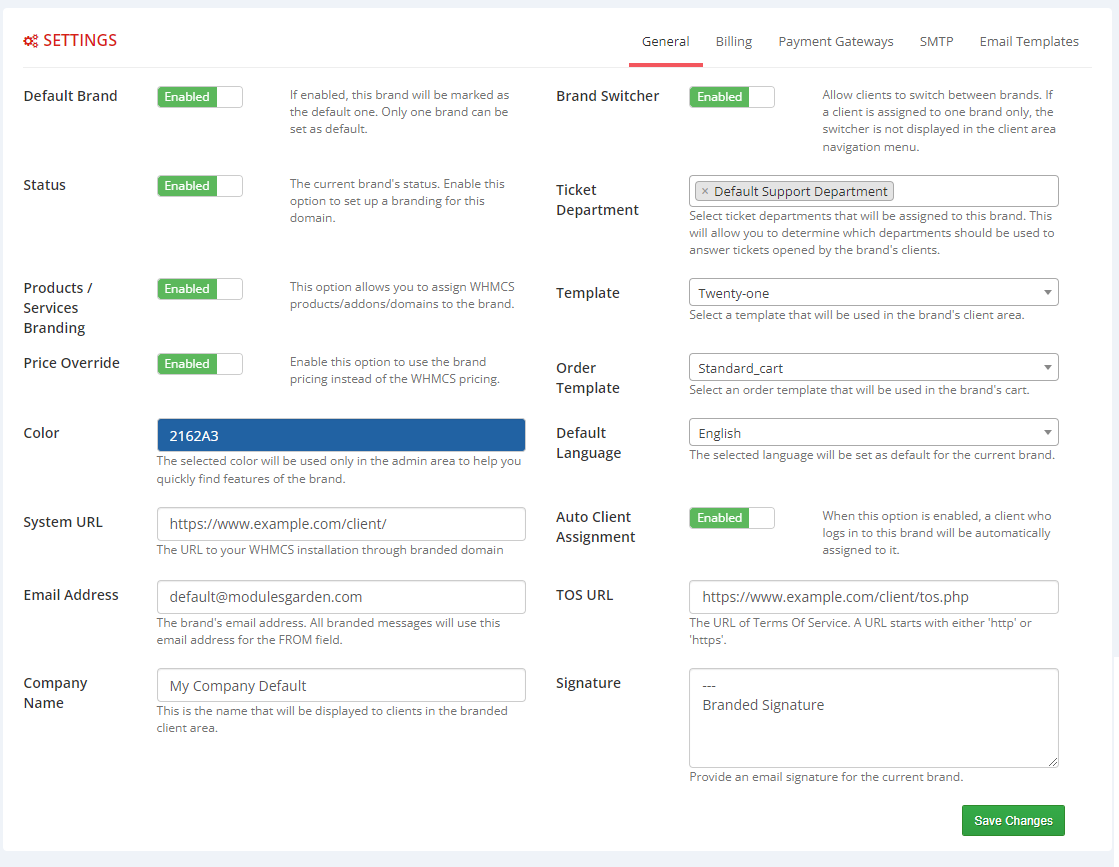
|

|
Billings
In the 'Billing' settings you can configure the design of your invoices.
Note: Remember to complete the 'Additional Settings' step during the module's installation to render the PDF invoices branded as well. |
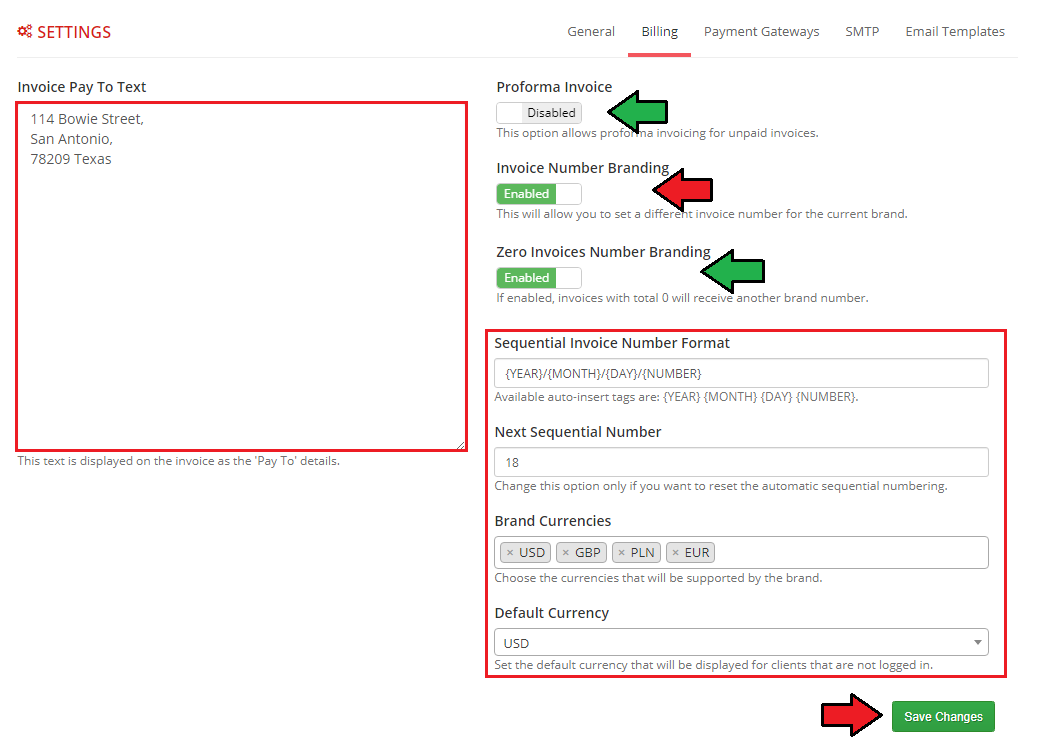
|
Payment Gateways
| This tab allows you to configure a payment gateway for the brand operating independently of the one configured in WHMCS. You can check the list of the currently available gateways in the Feature List. |

|
| Next, choose the desired gateway from the list and click on the 'Confirm' button. |
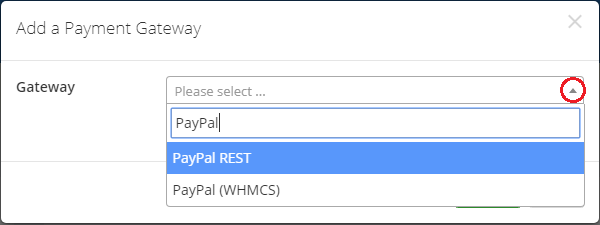
|
| Finally, fill out the payment gateway settings according to the details received from the provider. Save the configuration and activate the gateway. |
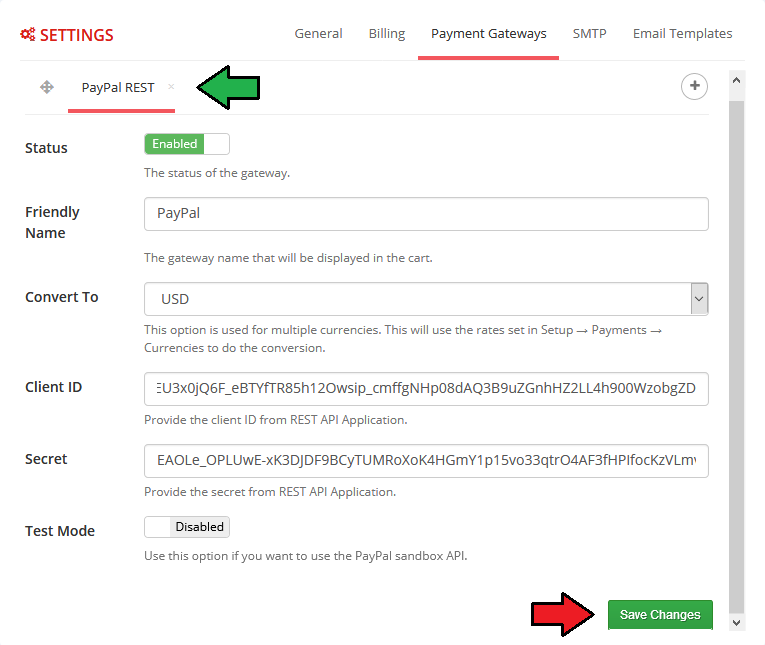
|
| Note: Multibrand For WHMCS can work with any gateway available within your WHMCS system. These gates will have a (WHMCS) label. The only limitation is that these payment gateways use the same settings for all brands. |
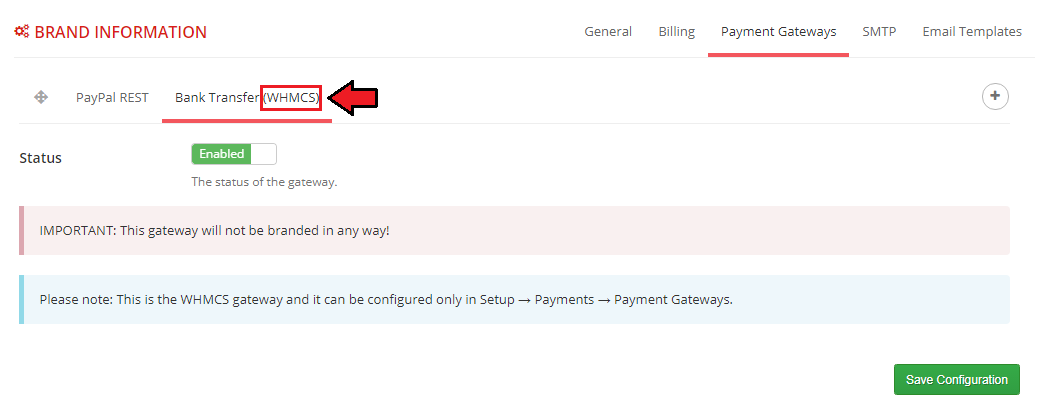
|
SMTP
| If you would like your brand to use an outgoing email configuration which is different from the one in the main WHMCS settings, you can do so in this tab. In addition, you can set your custom CSS email styling as well as the header and footer content. |
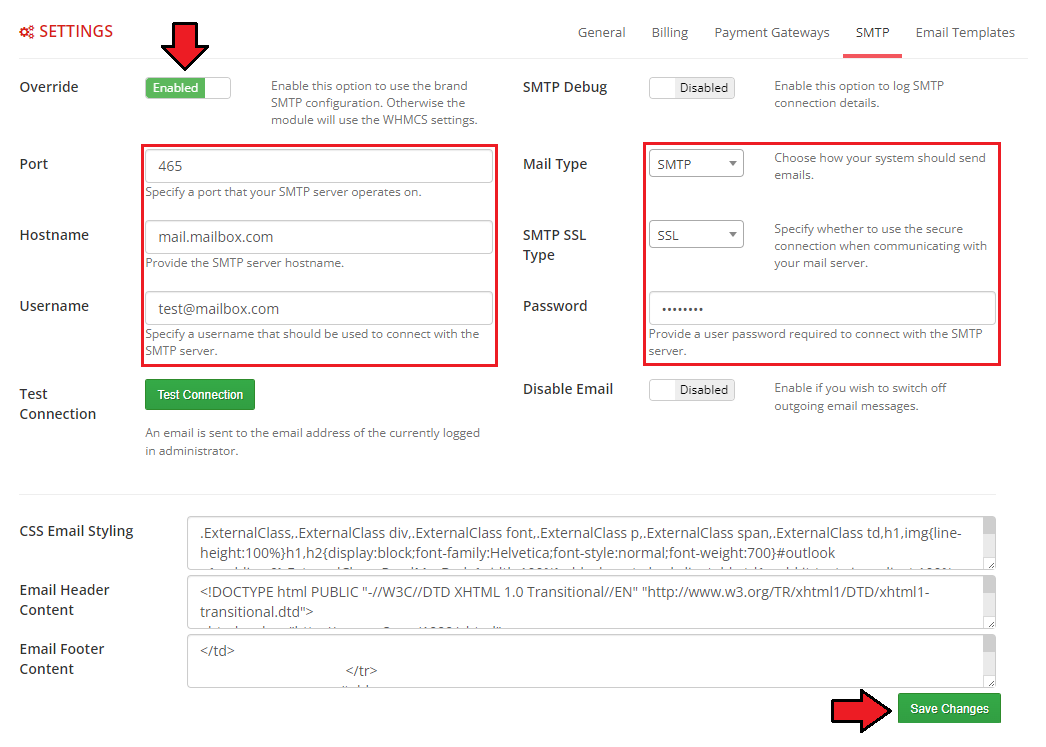
|
Email Templates
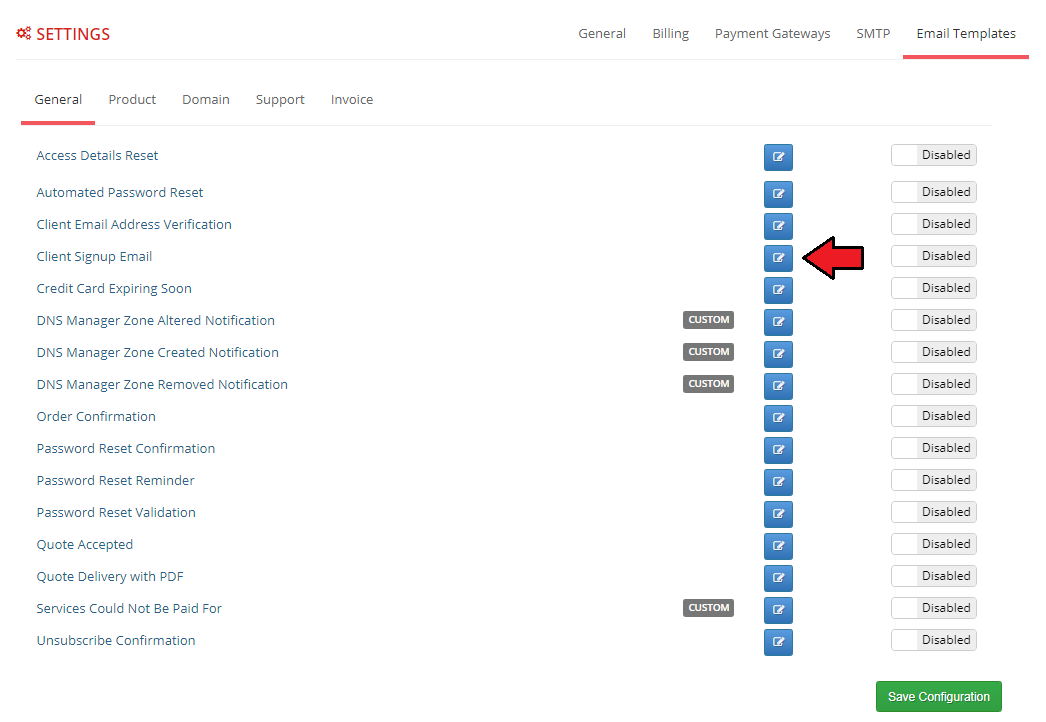
|
| Next, enter the desired subject and message content. You can also create more versions, in different languages. Additionally, along with editing the source code of a template you can use the available merge fields tags just like in the standard email templates. |
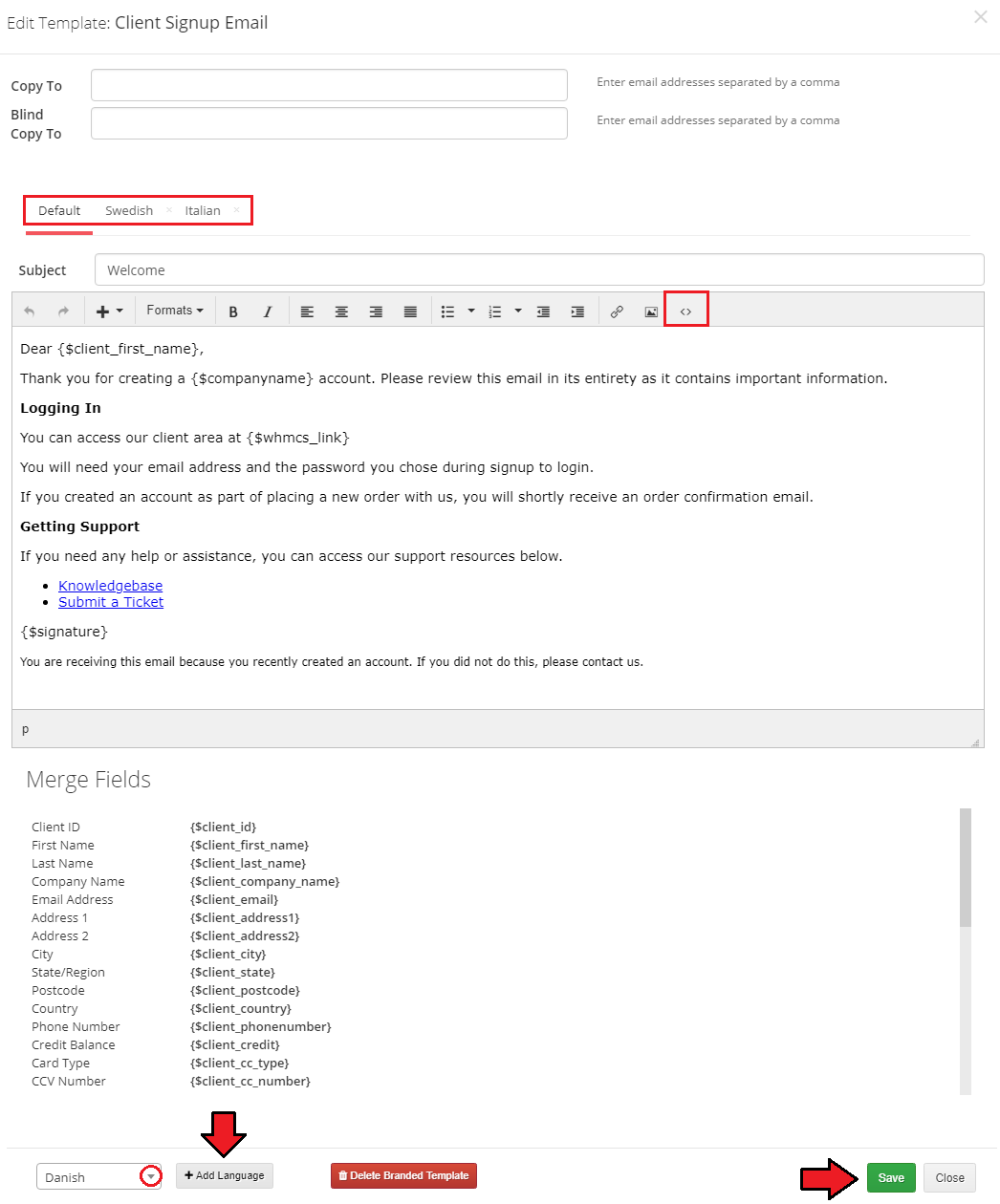
|
| Finally, enable the edited template and save the configuration. You will see the 'Branded' label next to the edited template. If you would like to restore the default template, simply return to its edition and click the 'Delete Template' button. |
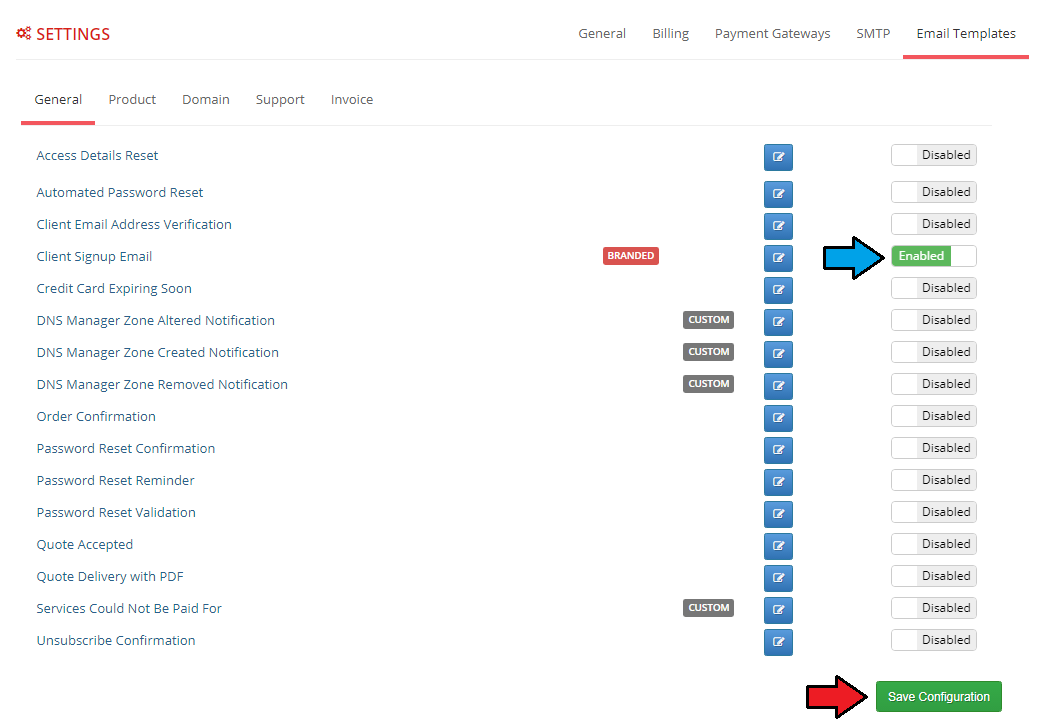
|
Services Pricing

|
| Select the product for which you want to set branded prices and click 'Save' . |
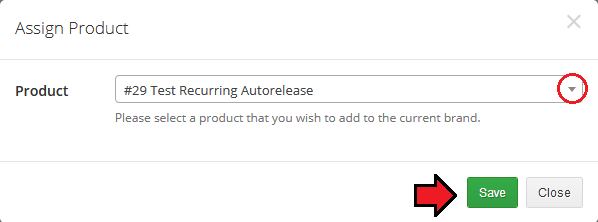
|
| Or you can add all your products at once thanks to 'Bulk Action' , just press the button marked with the green arrow. |
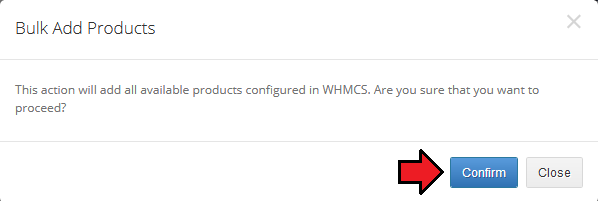
|
| Next, open the pricing editor of the chosen product. |

|
| Here you can configure the desired prices in selected billing cycles and currencies. You can also automatically fill out the amounts from the main product and update them, refreshing the currencies rate. Note: Availability of billing cycles, prices and currencies to be edited depends on their main configuration in WHMCS. |
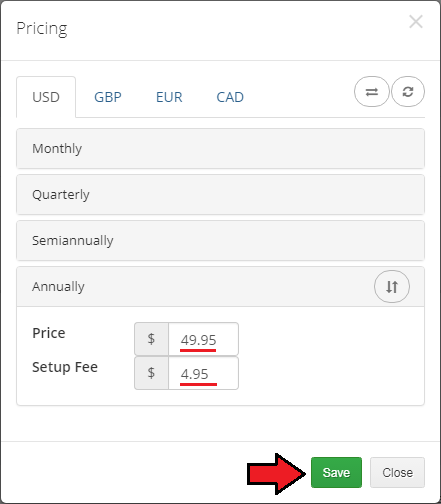
|
| From now on, the pricing for this product will be branded. You can also configure pricing for addons and domains in the same way. |
Relations
| In this section you can see which Clients, Services, Invoices, Quotes, Tickets, Knowledgebase, Downloads, Announcements and Promotions are assigned to this brand. In addition, you can manually manage, assign and unassign selected items to the brand. Note: Currently there is no option of mass management, assigning and unassigning selected items to the brand. This functionality will be implemented in future releases. |
Clients
| In the 'Clients' tab you can see customers who are assigned to the brand and the date on which they were assigned. Assignment takes place at the moment of client's registration for the branded domain. You can also manually assign the already existing customers to the brand or migrate them to another. Note: If the 'Auto Client Assign' option is enabled, then the customers who are already registered in one of the brands and try to log in to another brand will also be automatically assigned to it. |
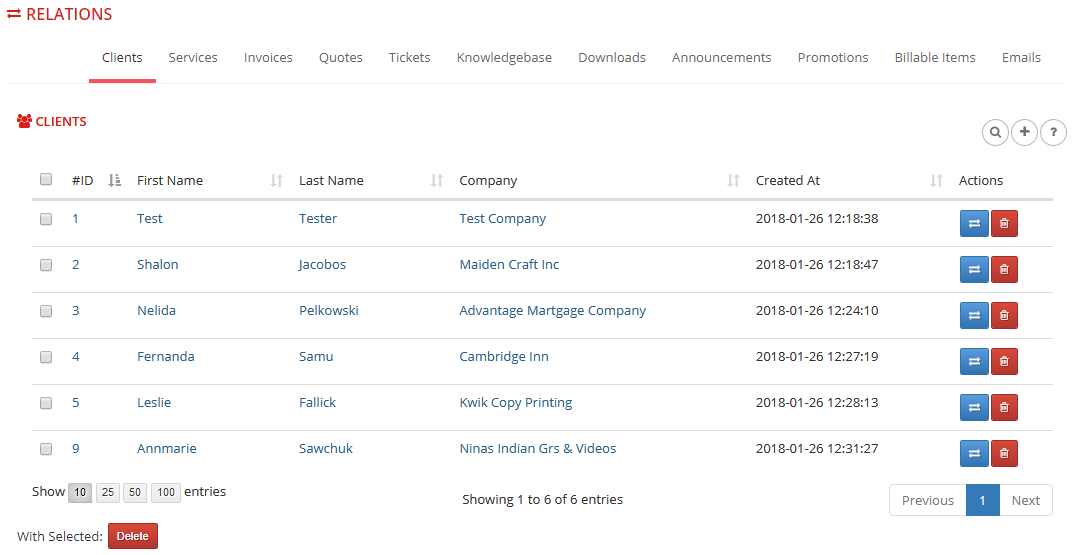
|
| To assign an existing client to the brand, press the 'Add' In the pop-up select a customer you want to add to the brand and press 'Save' . |
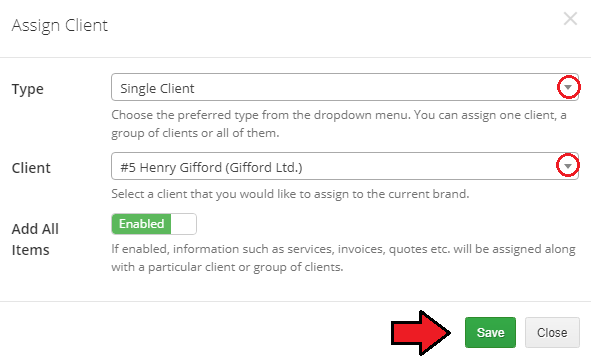
|
| You can also migrate the customers from this brand to another one. Click on the 'Migrate' |
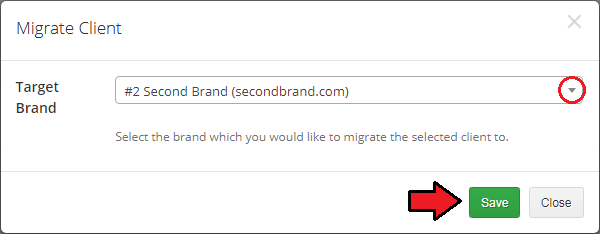
|
| And finally, if you want to delete a customer's relationship with this brand, click the 'Delete' |
Services
| In the 'Services' tab you can see which Services & Products, Addons and Domains have a relation with this brand. These are automatically added to the brand while ordering from the branded domain. |
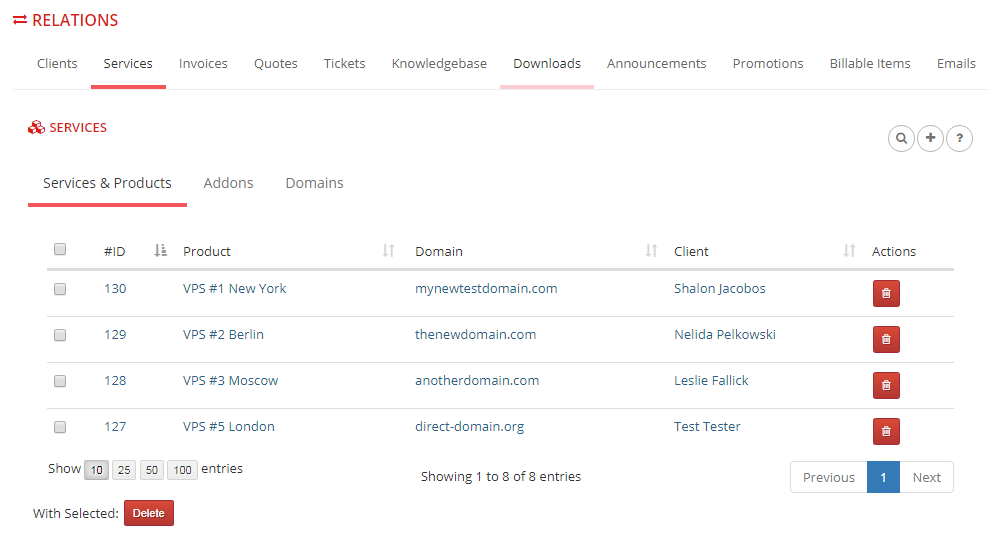
|
| You can also manually add a relation for a service that is not branded yet. Press the 'Add' |
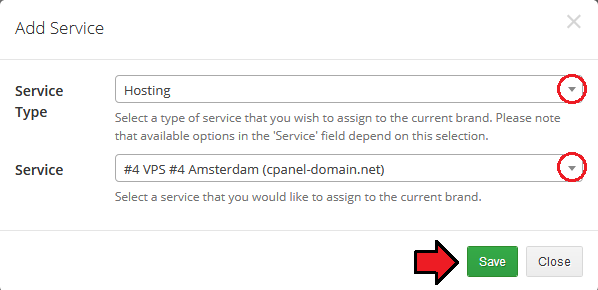
|
| Again, if you want to delete a service relation with the brand, press 'Delete' |
Invoices
| In this tab you can see which invoices have a relation with your brand. These invoices are automatically added to the brand after an order has been created from the branded domain. |
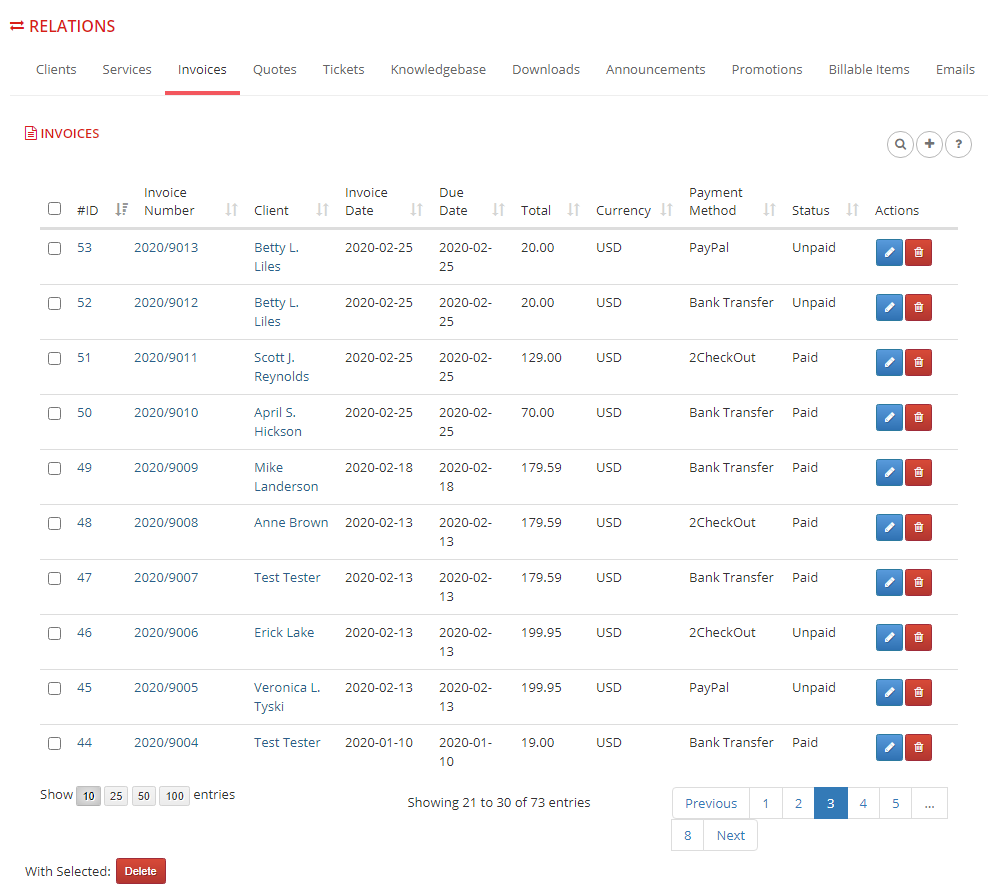
|
| You can also manually add a relation for the invoice that is not branded yet. Press 'Add' |
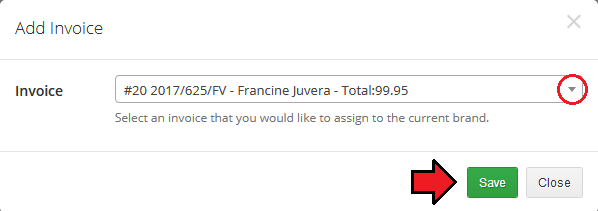
|
| If you want to delete an invoice relation with the brand, press the 'Delete' |
Quotes
| In this tab you can see which quotes have a relation with your brand. These are automatically added to the brand after an order has been created from the branded domain. |
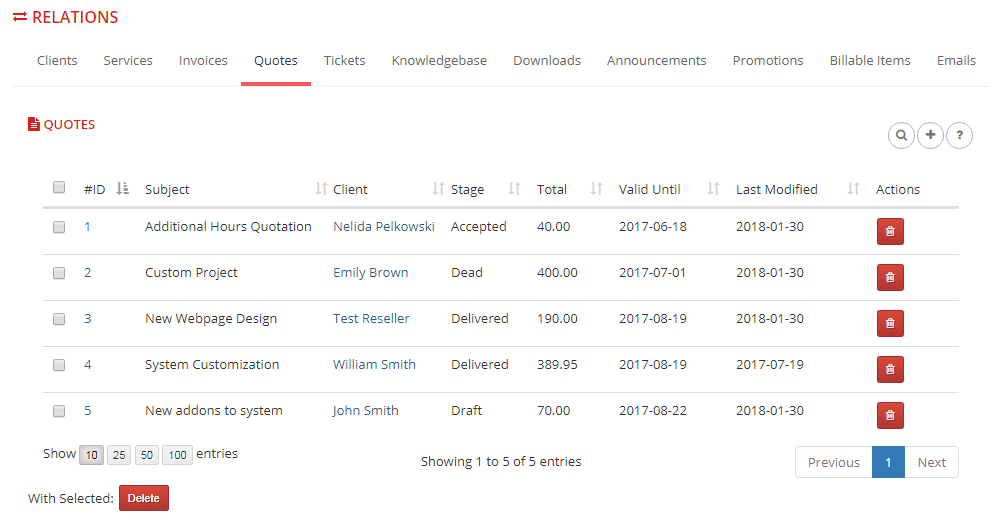
|
| You can also manually add a relation for the quote that is not branded yet. Press 'Add' |
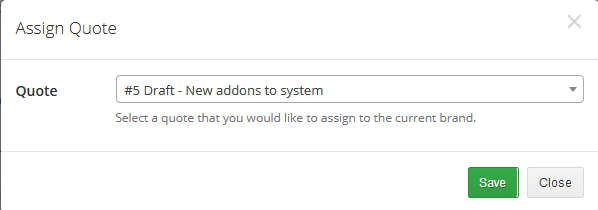
|
| If you want to delete a quote relation with the brand, press the 'Delete' |
Tickets
| In this tab you can see which tickets have a relation with the brand. These tickets are automatically branded after a ticket has been opened in one of the earlier branded departments. |
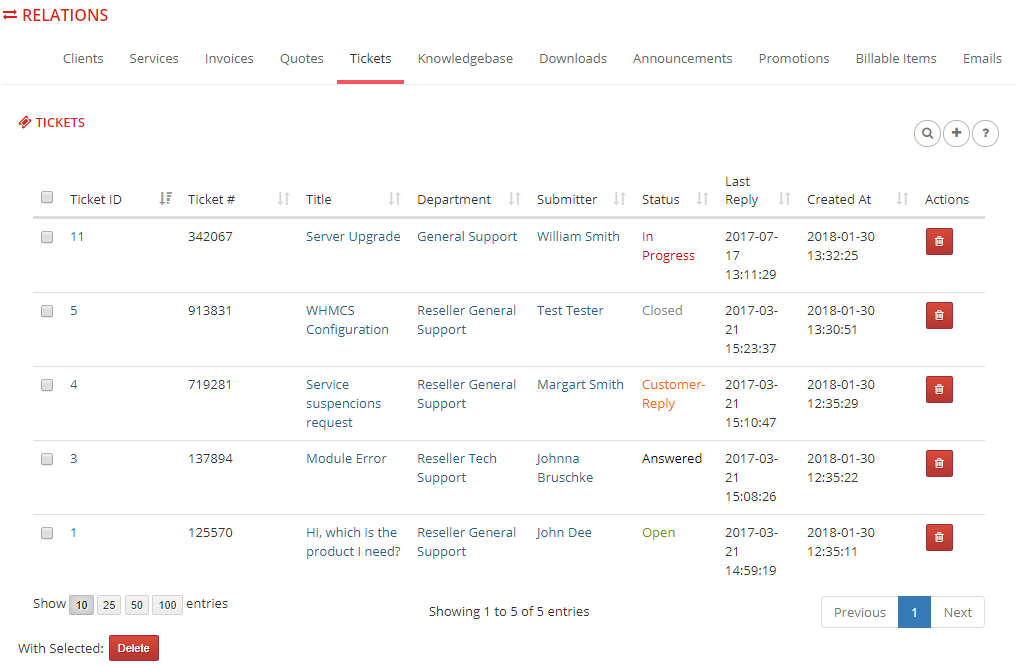
|
| You can also manually add a relation for the ticket that is not branded yet. Click on 'Add' |
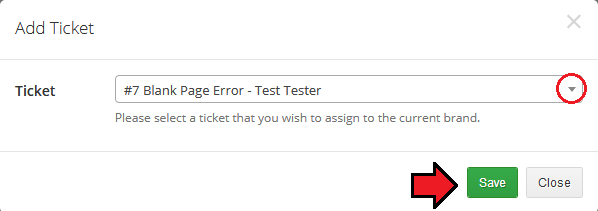
|
| If you want to delete a ticket relation with the brand, press the 'Delete' |
Knowledgebase
| In this tab you can see which of your knowledgebase articles have a relation with the brand. In addition, here you can find various statistics of views, useful points, number of votes and the date of assignment to the brand. |
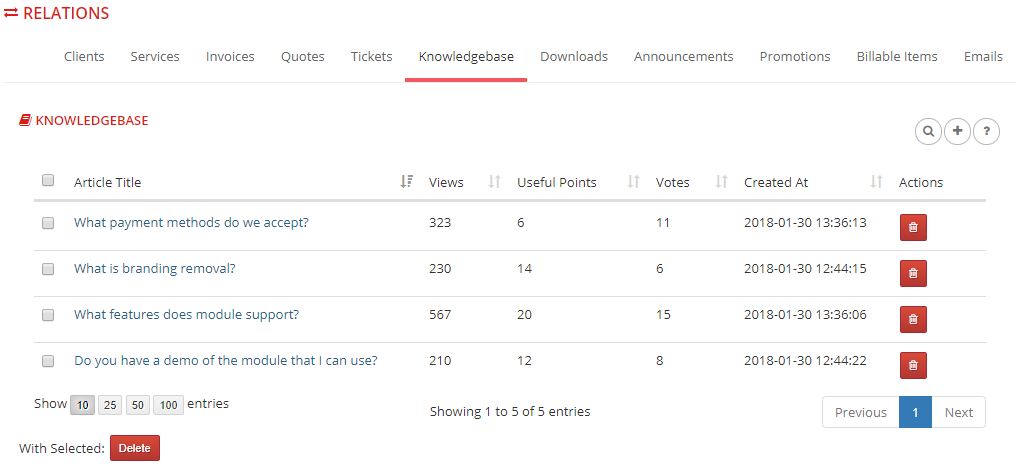
|
| To add a relation for the knowledgebase articles, press 'Add' |
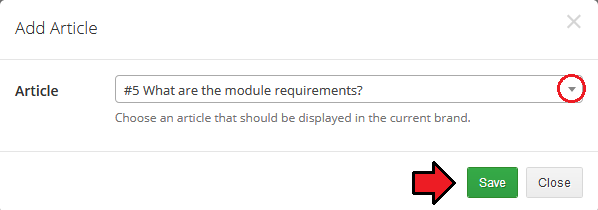
|
| If you want to delete a knowledgebase article relation with the brand, press the 'Delete' |
Downloads
| In this tab you can see which of your files available for download have a relation with the brand. In addition, here you can find a download category, type, number of downloads and the date of assignment to the brand. |
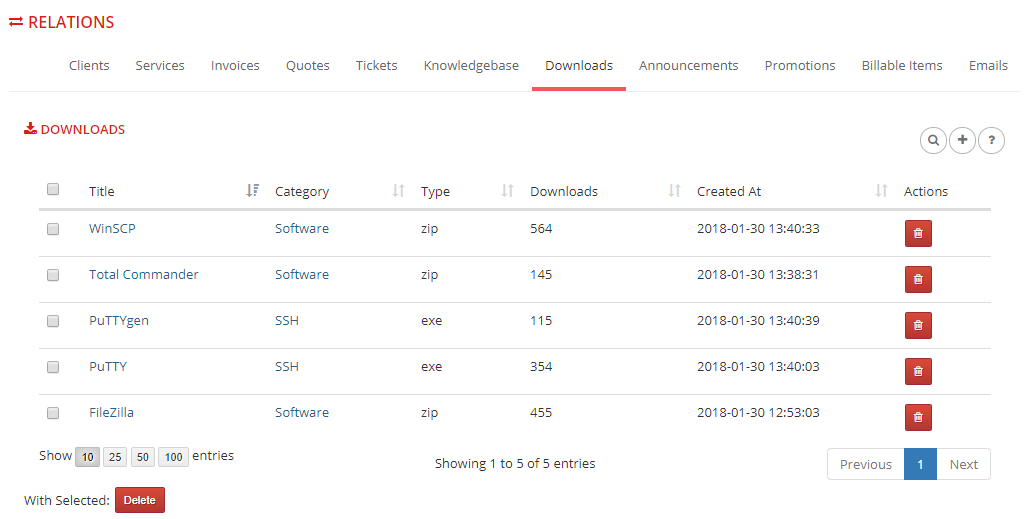
|
| To add a relation for the download, press the 'Add' |
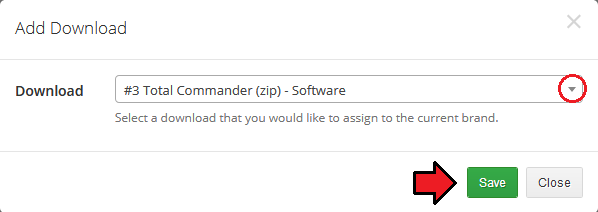
|
| If you want to delete a download relation with the brand, press 'Delete' |
Announcements
| In this tab you can see which of your announcements have a relation with the brand. In addition, here you can find the date of announcement creation, assignment to the brand and the published status. |
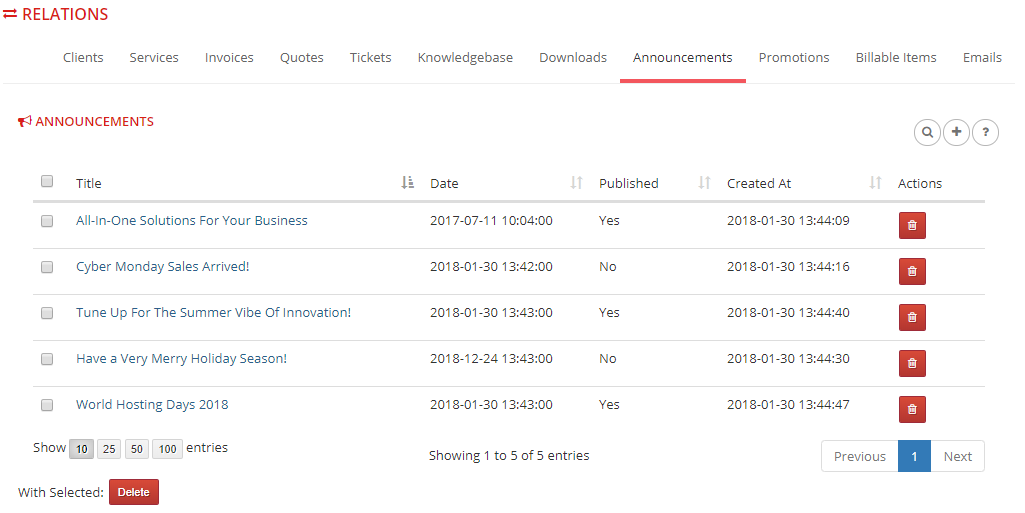
|
| To add a relation for the announcement, press the 'Add' |
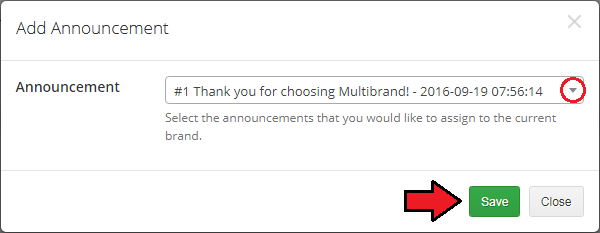
|
| If you want to delete an announcement relation with the brand, click on the 'Delete' |
Promotions
| In 'Promotions' you can generate promotions for specific brands. |
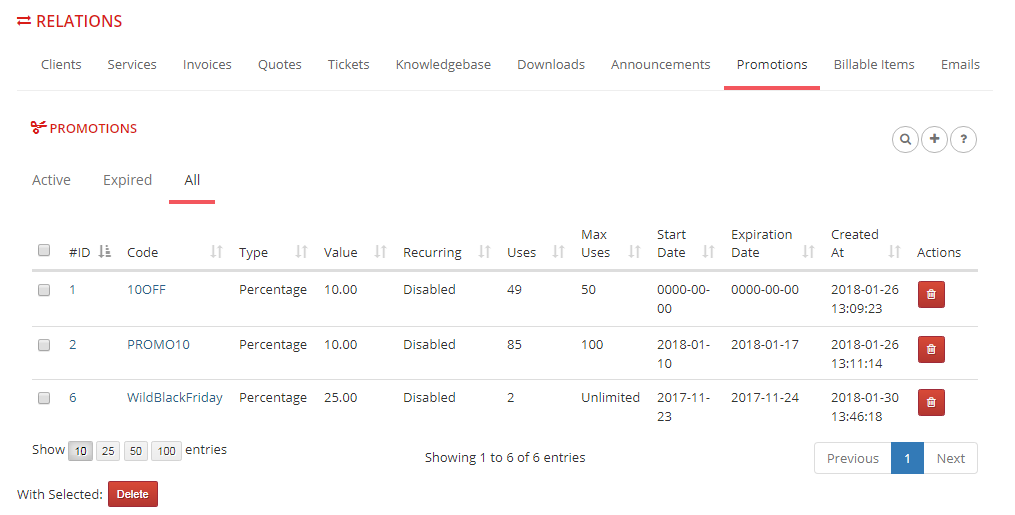
|
| To add a promotion, press the 'Add' |
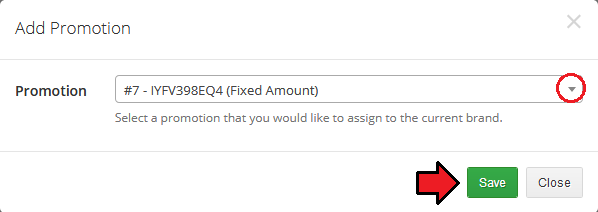
|
| If you want to delete a promotion relation with the brand, click on the 'Delete' |
Statistics
| In the 'Statistics' section you will find sales charts of selected brands. You can filter them by the date period and selected brands. |
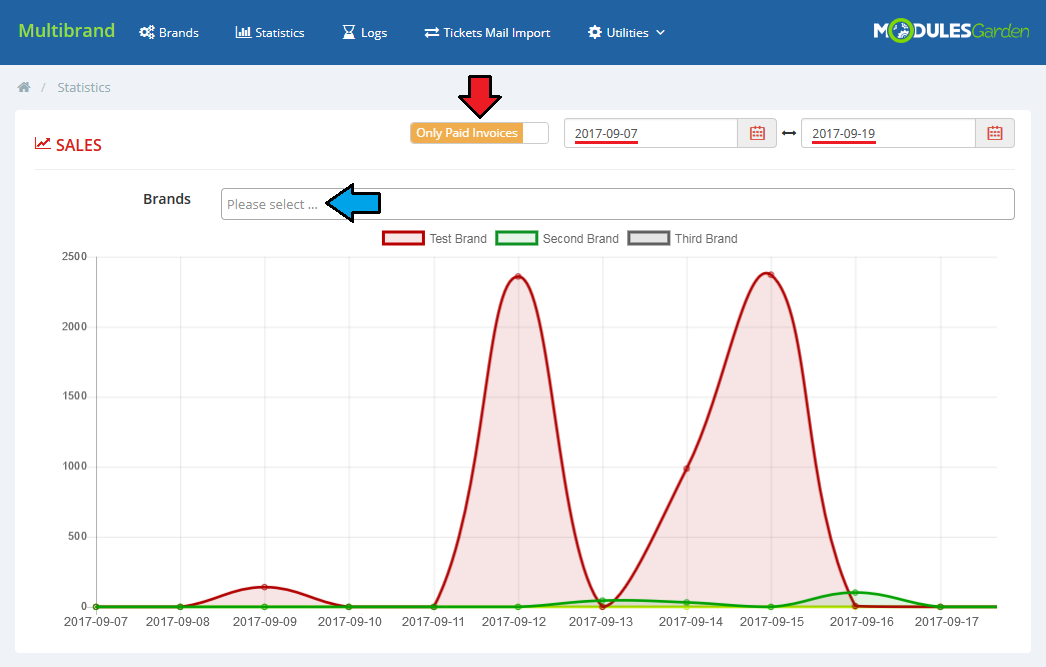
|
Logs
| 'Logs' section allows you to view warnings and errors related to your brands. Owing to the automation settings you can remove all logs or automatically delete them at a chosen time. |
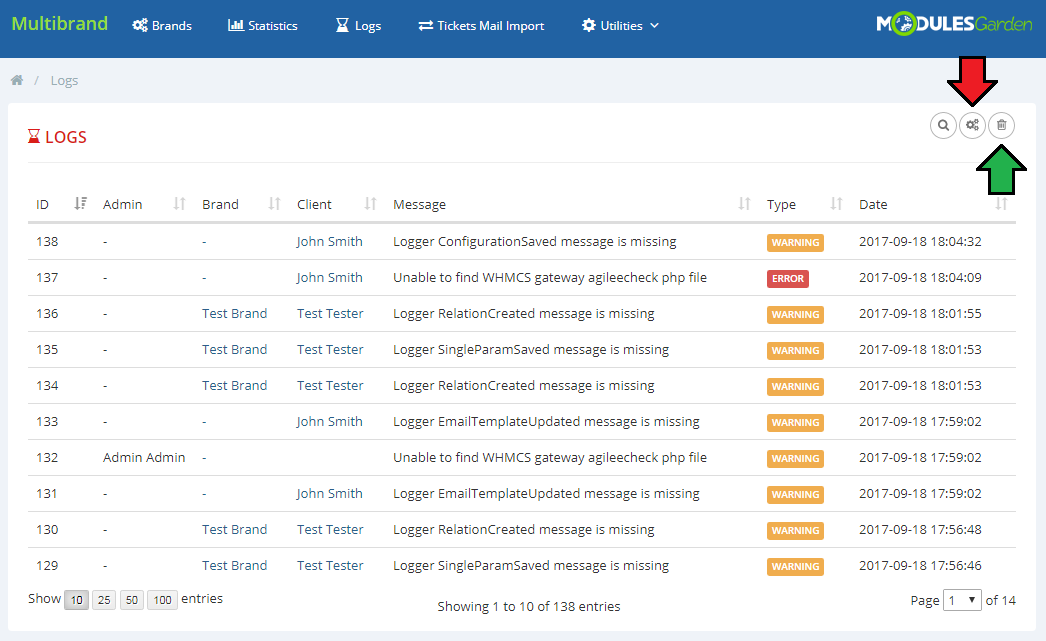
|
| The 'Auto Clear' option enables you to clear logs on the daily cron run. You can also enter a fixed number od days so when that time passes, the logs are automatically removed. |
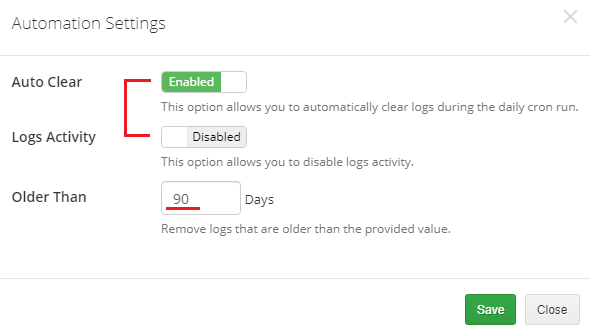
|
Ticket Piping
| The following section enables you to automatically define a brand email relation in order to automatically import messages sent to an email address into the support ticket system. Accordingly, clients will be able to open and reply to tickets outside the client area. |
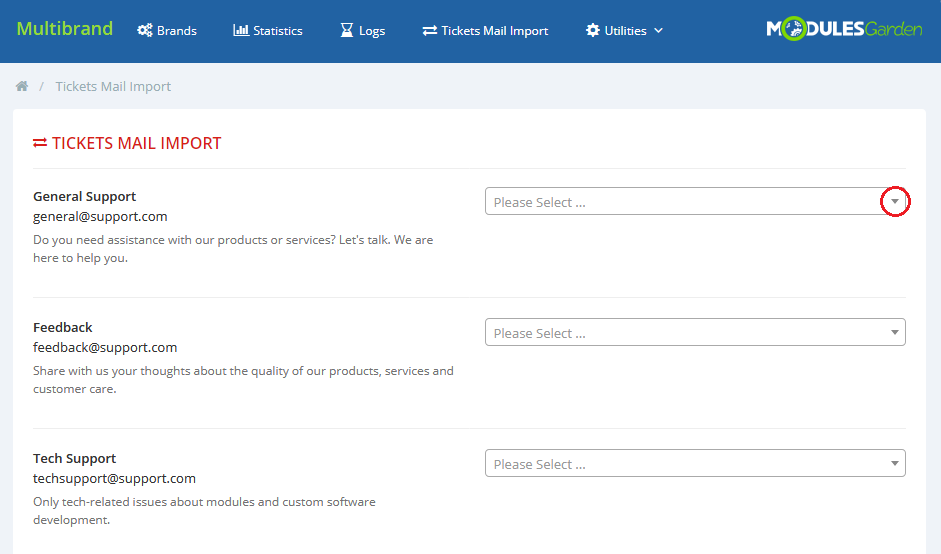
|
Branded Admin Area Functionalities
The module allows you to display information about the brand on the list of:
You can also directly select the brand when adding a new:
In the following sections you can find examples of such integration. |
Membership
| Multibrand For WHMCS makes the management of WHMCS easier through the introduction of the 'Brand Details' column. This column informs you about the membership of clients and invoices to a certain brand (more details will be added soon). |
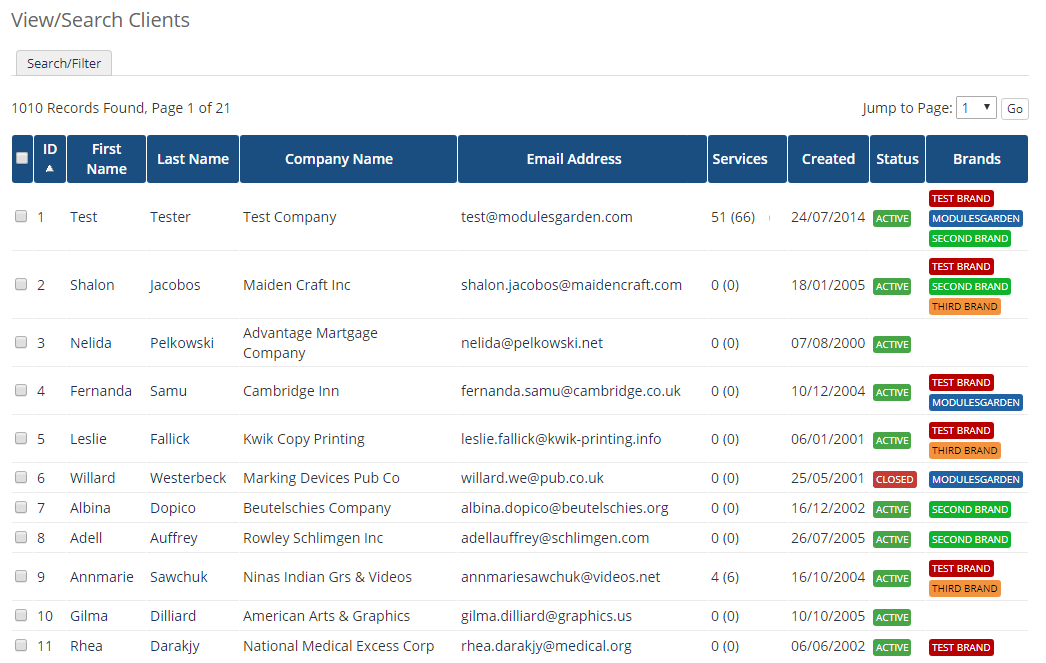
|
| It looks similar in the 'Invoice List'. |
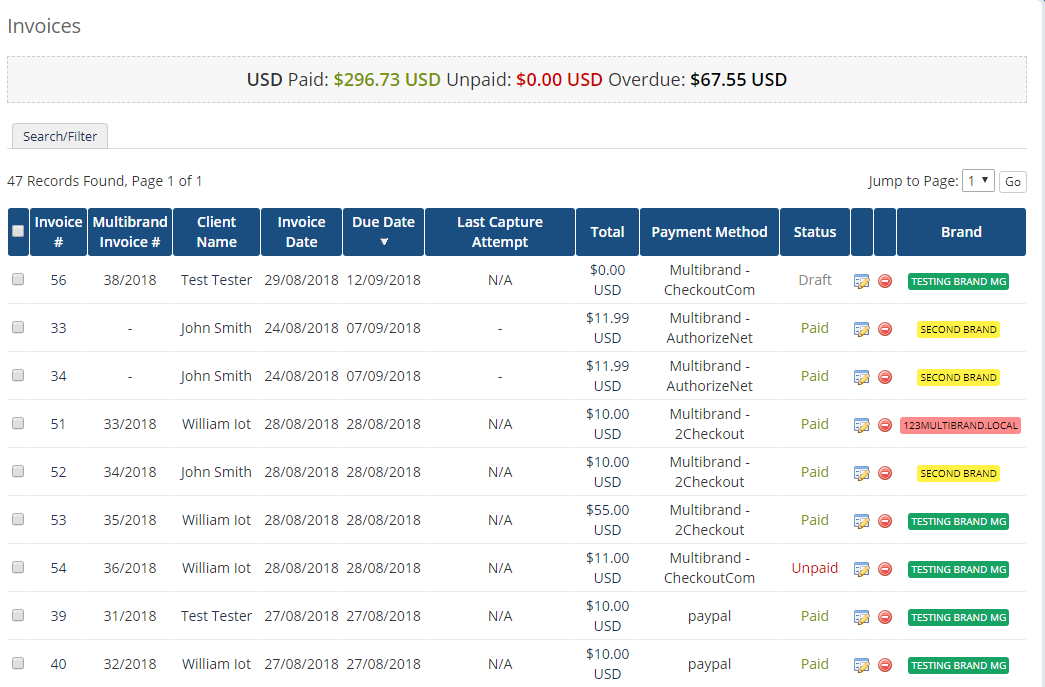
|
Order Creation
| If the administrator wants to manually create an order for a client, he/she can directly create a relation with the selected brand (provided that the client belongs to it). Additionally, they can also assign a payment gateway available in the given brand. |
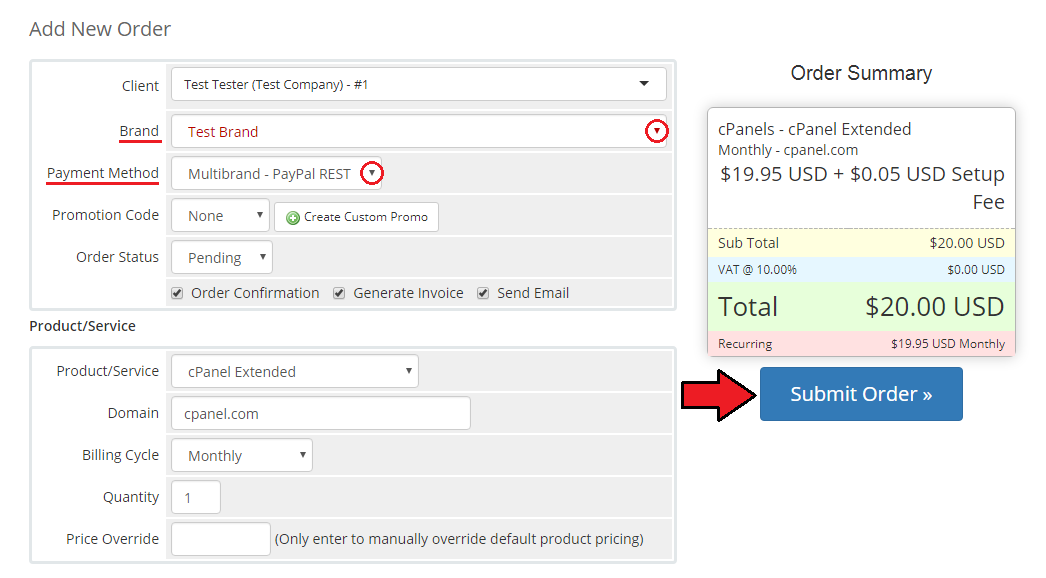
|
Invoices
| If the administrator creates a new invoice for a customer, he/she has the possibility to select a direct relationship with the given brand. |
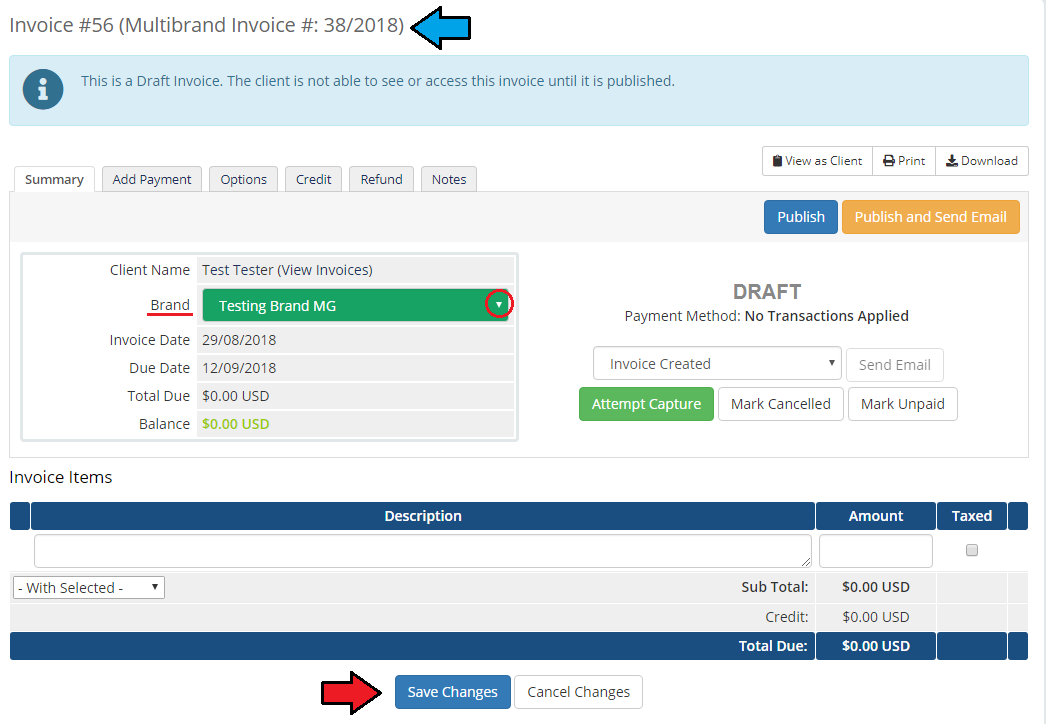
|
| Additionally, there is also a possibility to change the brand relation directly for the previously created invoices. |

|
| In other categories, the integration with brands is applied similarly. |
Branded Client Area
| Multibrand For WHMCS offers multiple client areas in one solution and allows you to have your clients assigned to them. For example, each brand domain can have a separate template, logo, language, services and invoices. |
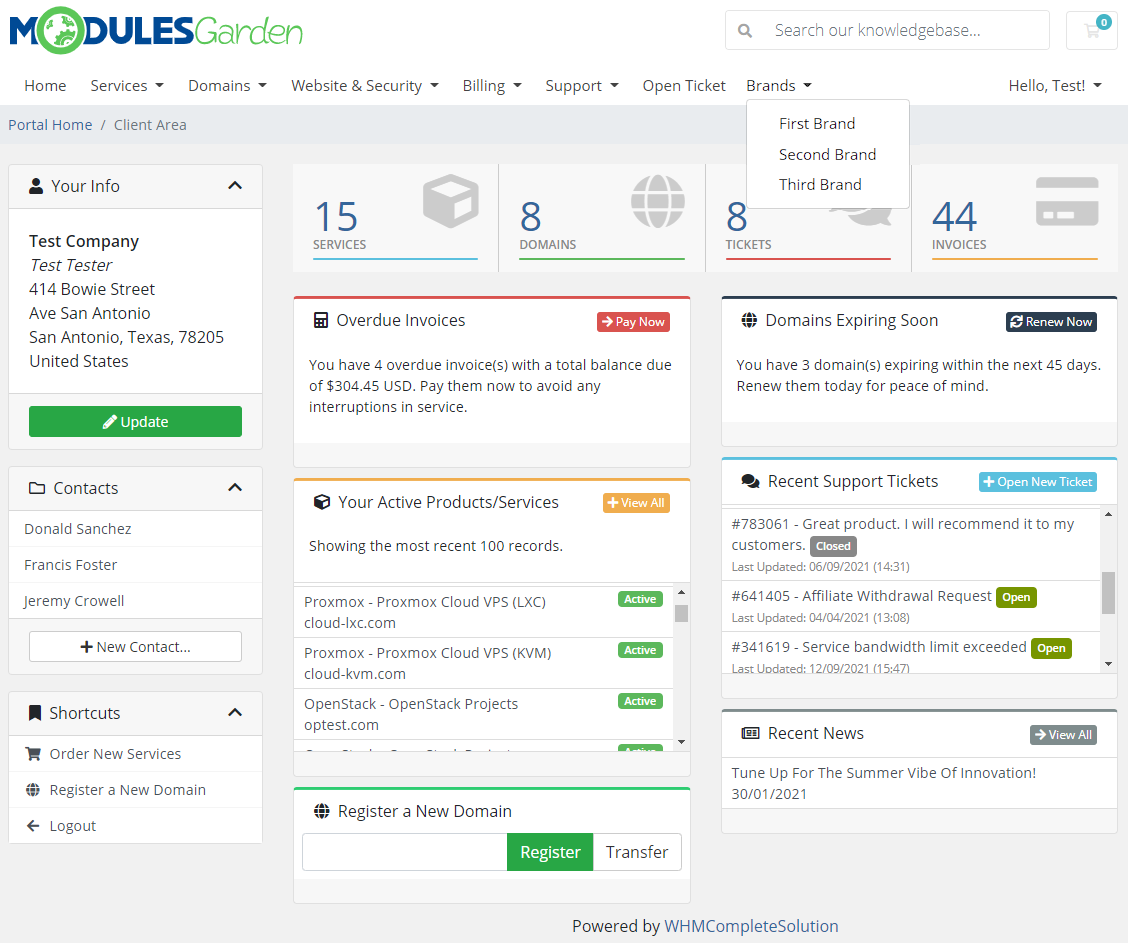
|
| On the following screen you can see invoices generated for a brand. |
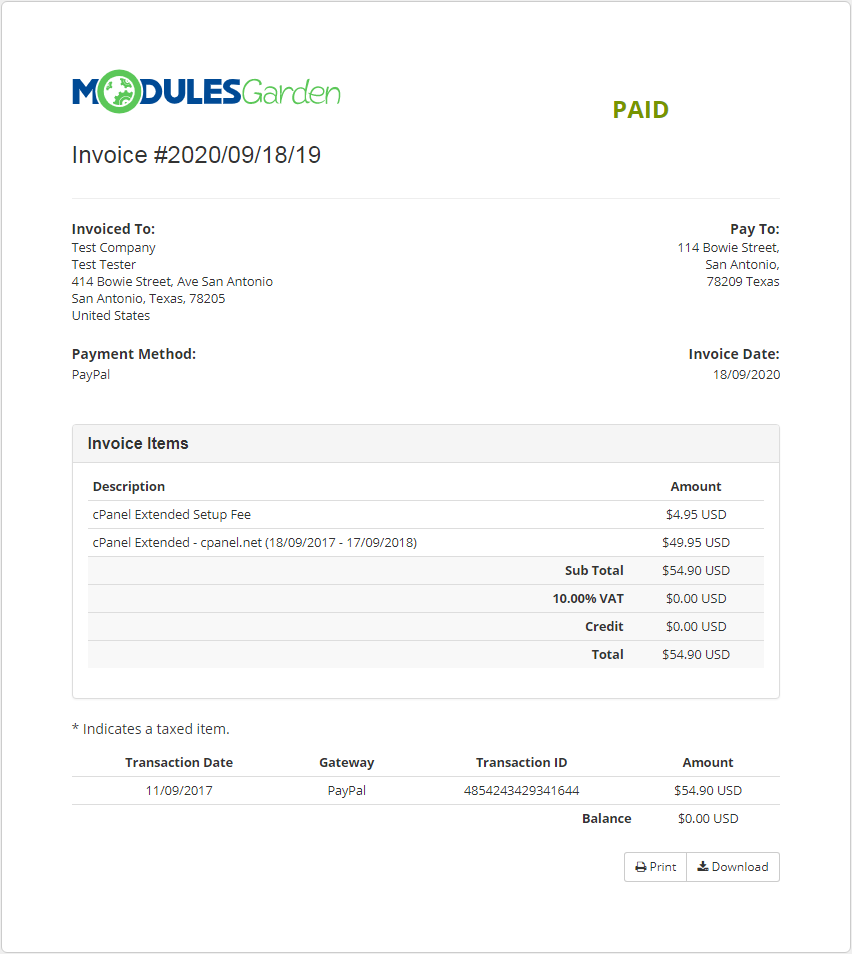
|
Branded Emails
| Brand configuration applies also to emails sent to clients. If you have enabled branding of a given template, the email sent to the client will be sent using the mailbox specified in the SMTP settings of the given brand. |
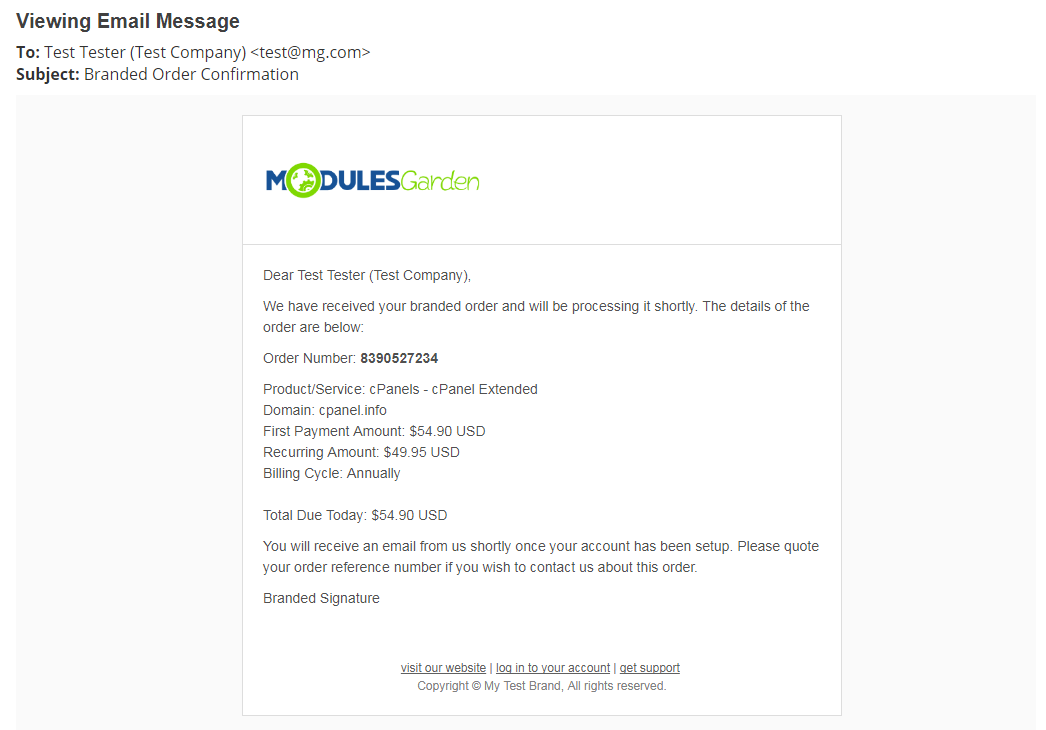
|
| You will find more information in the branded Email Templates configuration. |
Domains & CNAME Records Configuration
| In this section you will find guides on how to create a CNAME record in popular control panels. For instance, if your branded domain is 'reseller.com' and the domain with your WHMCS is 'whmcs.domain.com' , your CNAME will be 'www.reseller.com. CNAME whmcs.domain.com.'. |
| The domain used by each of the brands must be parked on the main domain. If a domain cannot be parked or it is a subdomain, you must create the CNAME records that will redirect from the brand domain to the main domain. Only when you have parked your domains can you move to setting the CNAME records on your panels. See the tips below. |
cPanel
| 1. Log in to your cPanel. |
| 2. Press 'Simple DNS Zone Editor' in the 'Domains' section. |
| 3. Select the domain you wish to manage from the menu. Note: This step is required only if you own more than one domain. |
| 4. Fill out the 'Name' field and the 'CNAME' record and press 'Add CNAME Record'. Note: To define the record's TTL, you have to use 'Advanced DNS Zone Editor'. |
DirectAdmin
| 1. Log in to your DirectAdmin. |
| 2. Click 'DNS Administration' . |
| 3. Afterward, select the desired domain. |
| 4. Fill out the full domain/subdomain into the CNAME record and press 'Add' next to it. Note: Do not forget to place a full stop at the end. |
Plesk
| 1. Log in to your Plesk panel. |
| 2. Press 'Domains' in the 'Hosting Services' section. |
| 3. Find the domain to be edited and click on the corresponding Control Panel link. Afterward, proceed to the 'Websites & Domains' tab and press 'DNS Settings' . |
| 4. Find the domain to be edited and click on the corresponding Control Panel link. Afterward, proceed to the 'Websites & Domains' tab and press 'DNS Settings'. |
| 5. Add a new record or edit the existing one. |
| 6. Now, change the record type to 'CNAME' and fill out both the 'Domain name' and the 'Canonical name'. Finish by pressing 'OK'. |
| Remember to restart your server once it is configured. |
SSL Certificate
| In this section you will find all information about the SSL certificate in WHMCS required to use Multibrand For WHMCS properly . If either your branded domains or WHMCS domain use the SSL connection, they should also support one of the below certificates.
This is the way WHMCS works. It cannot be considered the limitation of our module which uses the 'WHMCS System URL' scheme. |
cPanel
| Installing the SSL certificate for domains managed from cPanel consists of the following steps: |
| 1. Log in to your cPanel and press 'SSL/TSLS Manager' under the 'Security' section. |
| 2. Click on 'Manage SSL sites' under 'Install and Manage SSL for your site (HTTPS)'. |
| 3. (installing the certificate) Select the domain, paste the certificate along with the private key, and save the settings. |
| 4. (using the already installed certificate) Select the certificate from 'Browse Certificates' , and save the settings. |
| Alternatively, you can enable the AutoSSL solution that will automatically install domain-validated SSL certificates. Go here for more information. Note: AutoSSL function is unlikely to work for the CNAME entries, and therefore you should use virtual hosts (vhosts) instead. |
Branding Limitations
Version 2.1.0
| With the aim of better stability and support for future improvements, Multibrand For WHMCS has been completely rewritten in the 2.0 version. For this reason, some of the functionalities are not yet available or are operating in a limited way.
|
WHMCS
In this section we will list those elements of WHMCS that cannot be branded or may be working in an improper way.
|
WHMCS Modules and Others
In this section we will list the WHMCS modules and other services which do not support multibranding or do not cooperate with Multibrand For WHMCS at all.
|
Tips
| 1. The logo image is usually hard coded into the WHMCS template files. In order to use the logo file provided in the 'Multibrand For WHMCS' module, find the proper line in the template file and replace it with '{$logo}' variable. |
| 2. If you want Captcha security option to be displayed in your client area for all branded domains, you need to configure each of those domains in your Google Account as well. |
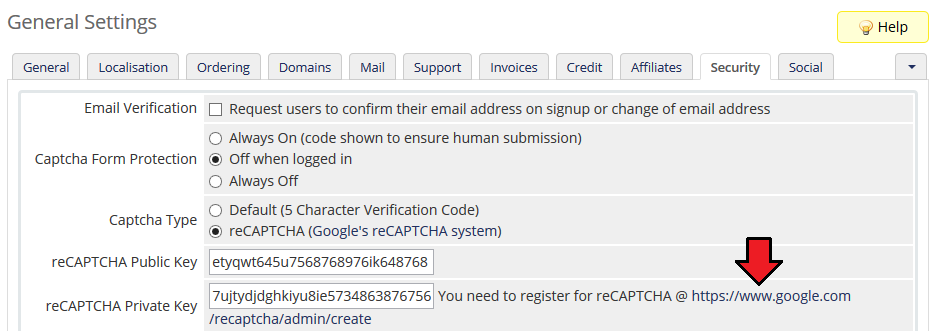
|
| 3. Note that it is not possible to merge tickets from different brands. |
| 4. Performing the 'Send Message' action on a clients list will result in sending branded emails only to the clients who are assigned to an individual brand. |
Update Instructions
| Essential guidance through the process of updating the module is offered here. In order to migrate the data from the 1.8.X version, simply activate the new module addon. |
Common Problems
| 1. When you have problems with connection, check whether your SELinux or firewall does not block ports. |
| 2. If your CNAME record is not working, remember that the first domain name in the CNAME record should be a branded domain. The second one is the domain on which you have your WHMCS. The redirection goes from the first domain to the second. |
| 3. If your branded domain or WHMCS domain are using the SSL connection, both of them need to have the same certificate. If both of them are using the same domain, you will need a wildcard certificate. |
| 4. Please remember that Multibrand For WHMCS works flawlessly with the WHMCS V7 and officially supported template 'Six' . In case you are using some custom template, you must be aware of the fact that unexpected errors might occur and we cannot take the responsibility for solving them. |
|
5. Multibrand For WHMCS module is not compatible with our Resellers Center For WHMCS. |